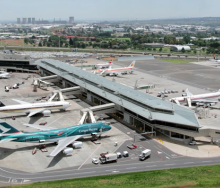THE privatisation of
SATC, which was
earmarked for the end
of 2014, has encountered
delays and obstacles,
leading to the exit of a
number of franchisees
who have joined competing
consortiums. Franchisee
numbers have almost
halved, declining from 86 in
2008 to 48 today.
SATC ceo, Bulelwa
Koyana, says the reason for
the resignation of members
in the past year has been
the delay in finalising
the divestment process.
However, she is confident
that there is a bright future
for SATC. “We continue to
recruit members and we
have been successful over
this period.”
“It is very sad,” says a
previous SATC franchisee.
“SAA should have followed
the same strategy as
Lufthansa with regard to
its divestment of Lufthansa
City Centre and handed
over the consortium to
the franchisees to run.
Lufthansa City Centre
started with 100 members;
today the consortium is 650
members strong worldwide.”
SAA had not responded to
TNW’s questions about the
reasons behind the delays
for the sale at time of going
to print. However, in the SAA
Group’s integrated financial
report, which was published
at the beginning of the year,
SAA said the divestment
of SATC continued to take
foremost priority. “To ensure
the long-term viability of the
business, it is critical that
the divestment process
be completed as soon as
possible,” the report said.
SAA admitted in the report
that there had been a great
deal of uncertainty arising
from the divestment
process, with a risk
of further franchisee
loss. “Competitors have
apparently been making
approaches to some
franchisees with the
intention of persuading
them to join their
consortiums. SATC head
office has continued to
monitor the situation closely
and has been implementing
a retention plan.”
The dual role of SAA as
both a supplier to and
a shareholder in SATC
presented a conflict
because SAA is unable
to invest further in SATC
without alienating other
retail groups who are
responsible for 96% of the
airline’s SA retail revenue.
“As a shareholder, SAA is
conflicted as it needs to
comply with the Competition
Act. The consequence
of this obligation is that
any favourable deals SAA
might wish to offer via
SATC cannot be offered
without contravening the
Act. The vertical relationship
between SAA and SATC
thus prevents SATC from
following market trends of
affiliation and consolidation
between competitors.
This results in a reduced
return on investment for
SATC franchisees, in turn
causing attrition and limiting
growth for the company as
franchisees migrate to more
attractive consortiums,” the
report said.of this obligation is that
any favourable deals SAA
might wish to offer via
SATC cannot be offered
without contravening the
Act. The vertical relationship
between SAA and SATC
thus prevents SATC from
following market trends of
affiliation and consolidation
between competitors.
This results in a reduced
return on investment for
SATC franchisees, in turn
causing attrition and limiting
growth for the company as
franchisees migrate to more
attractive consortiums,” the
report said.of this obligation is that
any favourable deals SAA
might wish to offer via
SATC cannot be offered
without contravening the
Act. The vertical relationship
between SAA and SATC
thus prevents SATC from
following market trends of
affiliation and consolidation
between competitors.
This results in a reduced
return on investment for
SATC franchisees, in turn
causing attrition and limiting
growth for the company as
franchisees migrate to more
attractive consortiums,” the
report said.of this obligation is that
any favourable deals SAA
might wish to offer via
SATC cannot be offered
without contravening the
Act. The vertical relationship
between SAA and SATC
thus prevents SATC from
following market trends of
affiliation and consolidation
between competitors.
This results in a reduced
return on investment for
SATC franchisees, in turn
causing attrition and limiting
growth for the company as
franchisees migrate to more
attractive consortiums,” the
report said.of this obligation is that
any favourable deals SAA
might wish to offer via
SATC cannot be offered
without contravening the
Act. The vertical relationship
between SAA and SATC
thus prevents SATC from
following market trends of
affiliation and consolidation
between competitors.
This results in a reduced
return on investment for
SATC franchisees, in turn
causing attrition and limiting
growth for the company as
franchisees migrate to more
attractive consortiums,” the
report said.













